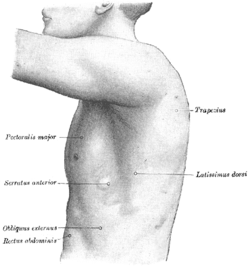Abdominal external oblique muscle
| Abdominal external oblique muscle | |
|---|---|
|
Muscles of the trunk. | |
|
The obliquus externus abdominis | |
| Details | |
| Origin | Ribs 5-12 |
| Insertion | Iliac crest, Pubic tubercle, Linea alba |
| Nerve | Thoracoabdominal nerves (T7-11) and Subcostal nerve (T12) |
| Actions | Contralateral rotation of torso |
| Identifiers | |
| Latin | Musculus obliquus externus abdominis |
| Dorlands /Elsevier | m_22/12549865 |
| TA | A04.5.01.008 |
| FMA | 13335 |
The external oblique muscle (of the abdomen) (also external abdominal oblique muscle) is the largest and the most superficial (outermost) of the three flat muscles of the lateral anterior abdomen.
Structure
The external oblique is situated on the lateral and anterior parts of the abdomen. It is broad, thin, and irregularly quadrilateral, its muscular portion occupying the side, its aponeurosis the anterior wall of the abdomen. In most humans (especially females), the oblique is not visible, due to subcutaneous fat deposits and the small size of the muscle.
It arises from eight fleshy digitations, each from the external surfaces and inferior borders of the fifth to twelfth ribs. These digitations are arranged in an oblique line which runs inferiorly and anteriorly, with the upper digitations being attached close to the cartilages of the corresponding ribs, the lowest to the apex of the cartilage of the last rib, the intermediate ones to the ribs at some distance from their cartilages.
The five superior serrations increase in size from above downward, and are received between corresponding processes of the serratus anterior muscle; the three lower ones diminish in size from above downward and receive between them corresponding processes from the latissimus dorsi. From these attachments the fleshy fibers proceed in various directions.
Those from the lowest ribs pass nearly vertically downward, and are inserted into the anterior half of the outer lip of the iliac crest; the middle and upper fibers, directed downward (inferiorly) and forward (anteriorly), become aponeurotic at approximately the midclavicular line. This aponeurosis formed from fibres from either side of the external oblique decussates at the linea alba.
The aponeurosis of the external oblique muscle forms the inguinal ligament. The muscle also contributes to the inguinal canal.
Just deep to the external oblique is the internal oblique muscle.
Innervation
The external oblique muscle is innervated by ventral branches of the lower 6 thoracoabdominal nerves and the subcostal nerve on each side.
Blood supply
The cranial portion of the muscle is supplied by the lower intercostal arteries, whereas the caudal portion is supplied by a branches of either the deep circumflex iliac artery or the iliolumbar artery.
Function
The external oblique functions to pull the chest downwards and compress the abdominal cavity, which increases the intra-abdominal pressure as in a valsalva maneuver. It also has limited actions in both flexion and rotation of the vertebral column. One side of the obliques contracting can create lateral flexion.
Society and culture
Training
- Crunch (exercise)
- Side plank
- Sit-up (exercise)
Additional images
-
Posterior view of muscles connecting the upper extremity to the vertebral column. Posterior part of abdominal external oblique muscle labeled.
-

Diagram of a transverse section of the posterior abdominal wall, to show the disposition of the lumbodorsal fascia.
-

The subcutaneous inguinal ring.
-

Diagram of sheath of Rectus.
-

Diagram of a transverse section through the anterior abdomina wall, below the linea semicircularis.
-

Femoral sheath laid open to show its three compartments.
-

Transverse section through the middle of the first lumbar vertebra, showing the relations of the pancreas.
-

The left side of the thorax.
-

Surface anatomy of the front of the thorax and abdomen.
-

Lumbar triangle
-

External abdominal oblique muscle
-
External abdominal oblique muscle.Anterior abdominal wall.Deep dissection.Anterior view.
See also
References
This article incorporates text in the public domain from the 20th edition of Gray's Anatomy (1918)
External links
- 1335492666 at GPnotebook
- Anatomy image:7061 at the SUNY Downstate Medical Center
- Cross section image: pembody/body8a - Plastination Laboratory at the Medical University of Vienna
| ||||||||||||||||||||||||||||||||||||||||

